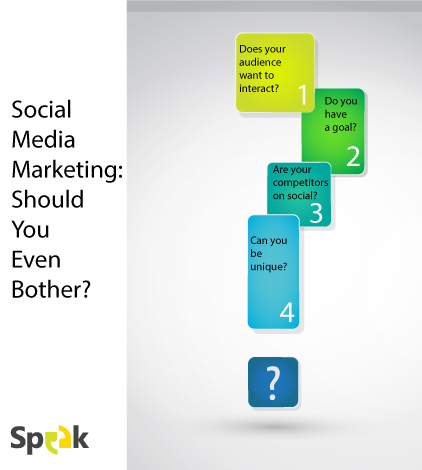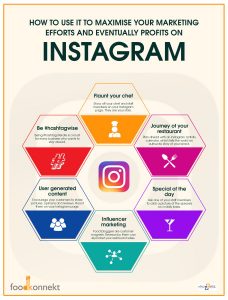Social media polarizes marketers. There are those who believe, without question, that every business needs social media. And then there are those who argue that the ROI is tough to prove—which makes a full social strategy hard to justify. Amid these conflicting opinions, new business owners and marketers are struggling to decide which road to take. Stop the insanity and clarify your stance on social by answering the questions below.

Does your target audience want to interact with you on social media?
Oursocialtimes.com reports that “over 50% of Internet users either don’t use any social networks, or use just one.” In other words, don’t assume your customers are on social. If you aren’t clear on your customer’s social media habits, survey them and ask.
Next, go one step further and think about how your business fits with your customer’s social identity. People like to associate themselves publicly with good causes, like animal rescue groups and charity foundations. But people are less likely to align themselves publicly with a marriage and family counselor, because it could imply household dysfunction.
Do you have a clear, measurable goal for social?
The social space is vastly more competitive than it used to be, so “showing up” without a clear goal is not worth your time. Think about what you want to achieve. The options usually fall into one of these: better customer relationships, better customer service, lead generation (including referrals and advocate marketing) and sales.
Better customer relationships
Social (along with other digital strategies) might help you connect with customers between purchases. So consider how often people need to buy your product.
If the product is a once-in-a-lifetime product (like a burial plot), you may not need to maintain relationships or provide extra post-sale support.
If the product is a big ticket item that’s purchased every few years, social media can work with other marketing efforts to keep you in touch with customers between purchases.
If the product is purchased frequently, social media will have less influence over your customer relationships. The quality of the purchase transaction is the factor to focus on in that scenario.
Metrics that may help you measure your effectiveness in customer retention include social engagement and trends in customer purchase frequency and average order value.
Better customer service
You probably don’t want to offer full-fledged service via social, but do you have frequent status updates that your customers need to know about? These updates might be as simple as your hours, or more complex, product-related information like recalls or upgrades.
Metrics that may help you measure your effectiveness in social service include trends in customer service calls and complaints.
Lead generation (includes referrals and advocate marketing) and sales
You can use social to push out content that supports your lead and sales programs. This is an inbound strategy that brings prospects to you. Or, you can use social to find individuals who may be targets for your products or services. You’d then reach out to these people via other channels. This latter option doesn’t require you to maintain an official business presence on social, so I won’t focus on that here.
Pushing out content on social to get prospects to your website is effective if you are already generating leads or sales on your site. Social just gets the people into the lead funnel; it doesn’t magically do the conversion work for you.
You may need to run ads or tap your existing customers to advocate for you on social. The advocacy path makes sense if you want customers who are similar demographically to your existing customers. If you are looking for a different audience, you probably won’t reach them by way of referrals from existing customers.
To measure your performance in lead generation and sales, start monitoring social’s contribution to your leads and/or sales. Make sure to consider that social might be an early step in the research process for your customer. For example, someone might click to your site from Twitter, then later come to your site from organic search, and then finally click on an ad and make a purchase. If you are tracking leads and/or sales in Google Analytics, the multi-channel funnel reports will show you this activity.
Are your competitors on social?
You should always check out what your competitors are doing on social before you decide on your own strategy. You’re not doing this so you can copy their strategy; your goal is clarify your thinking on how social might work for you and your niche. It’s easy enough to see if your competitor’s Facebook and Twitter content is sparking engagement among the follower base. A caveat here: sometimes the engagement is coming mainly from the competitor’s employees. This can be hard to uncover, but be on the lookout for comments and shares from the same people over and over again.
Can you be unique?
This is the million-dollar question. Consumers are short on time, and they need some reason for interacting with you on social media. If you can’t be creative and interesting, then establishing a community on social will be a grind. Think about what you can do to enrich people’s lives and how much that will cost in time and resources. If you’re not ready to take it on, it’s OK to say no to social.
This article originally appeared on the Speak digital marketing blog and has been republished with permission.
(318)






